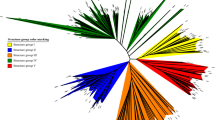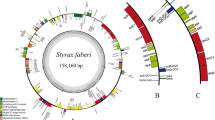Abstract
London plane tree (Platanus acerifolia Willd.) is an important member of the Platanaceae family, being popular as an urban landscaping tree. Here, we report the isolation of five MADS-box genes from the basal angiosperm, Platanus acerifolia. Sequence and phylogenetic analyses identified FRUITFUL-like, APETELA3-like, AGAMOUS-like, SEPALLATA1-like and SEPALLATA3-like sequences and, hence, we term the respective Platanus acerifolia genes as PlacFUL, PlacAP3, PlacAG, PlacSEP1 and PlacSEP3. From these identities we infer that they represent candidate A-, B-, C-class and two E-class genes, respectively. The conserved MIK or MIKC domains from the nucleotide and protein sequences of PlacFUL, PlacAP3, PlacAG, PlacSEP1 and PlacSEP3 were analyzed using the maximum-likelihood, MrBayes and neighbor-joining methods. The results confirmed P. acerifolia as a basal eudicot. Expression pattern was determined by reverse transcriptase PCR, which showed all paralogous genes have distinct expression patterns, suggesting that they had undergone functional divergence.







Similar content being viewed by others
References
Alvarez-Buylla ER, Pelaz S, Liljegren SJ, Gold SE, Burgeff C, Ditta GS, de Pouplana LR, Martínez-Castilla L, Yanofsky MF (2000) An ancestral MADS-box gene duplication occurred before the divergence of plants and animals. Proc Natl Acad Sci USA 97:5328–5333
Becker A, Theissen G (2003) The major clades of MADS-box genes and their role in the development and evolution of flowering plants. Mol Phylogenet Evol 29:464–489
Bowman JL, Drews GN, Meyerowitz EM (1991) Expression of the Arabidopsis floral homeotic gene AGAMOUS is restricted to specific cell types late in flower development. Plant Cell 3:749–758
Bowman JL, Alvarez J, Weigel D, Meyerowitz EM, Smyth DR (1993) Control of flower development in Arabidopsis thaliana by APETALA1 and interacting genes. Development 119:721–743
Busch MA, Bomblies K, Weigel D (1999) Activation of a floral homeotic gene in Arabidopsis. Science 285:585–587
Coen ES, Meyerowitz EM (1991) The war of the whorls: genetic interactions controlling flower development. Nature 353:31–37
De Bodt S, Raes J, Van de Peer YV, Theissen G (2003) And then there were many: MADS goes genomic. Trends Plant Sci 8:475–483
Ditta G, Pinyopich A, Robles P, Pelaz S, Yanofsky M (2004) The SEP4 gene of Arabidopsis thaliana functions in floral organ and meristem identity. Curr Biol 14:1935–1940
Drinnan AN, Crane PR, Hoot SB (1994) Patterns of floral evolution in the early diversification of non-magnoliid dicotyledons (eudicots). Plant Syst Evol 8(Suppl):93–122
Endress PK (1987a) The early evolution of the angiosperm flower. Trends Ecol Evol 2:300–304
Endress PK (1987b) Floral phyllotaxis and floral evolution. Bot Jahrb Syst 108:417–438
Endress PK (1994) Diversity and evolutionary biology of tropical flowers. Cambridge University Press, Cambridge
Ferrario S, Immink RG, Angenent GC (2004) Conservation and diversity in flower land. Curr Opin Plant Biol 7:84–91
Goto K, Meyerowitz EM (1994) Function and regulation of the Arabidopsis floral homeotic gene PISTILLATA. Genes Dev 8:1548–1560
Gu Q, Ferrandiz C, Yanofsky MF, Martienssen R (1998) The FRUITFULL MADS-box gene mediates cell differentiation during Arabidopsis fruit development. Development 25:1509–1517
Guindon S, Gascuel O (2003) A simple, fast, and accurate algorithm to estimate large phylogenies by maximum likelihood. Syst Biol 52:696–704
Helliwell CA, Wesley SV, Wielopolska AJ, Waterhouse PM (2002) High-throughput vectors for efficient gene silencing in plants. Funct Plant Biol 29:1217–1225
Honma T, Goto K (2001) Complexes of MADS-box proteins are sufficient to convert leaves into floral organs. Nature 409:525–529
Irish VF (2003) The evolution of floral homeotic gene function. BioEssays 25:637–646
Jofuku KD, den BoerI BGW, VanMontaguI M, Okamuroa JK (1994) Control of Arabidopsis flower and seed development by the homeotic gene APETALA2. Plant Cell 6:1211–1225
Kaufmann K, Melzer R, Theissen G (2005) MIKC-type MADS domain proteins: structural modularity, protein interactions and network evolution in land plants. Genes 347:183–198
Keck E, McSteen P, Carpenter R, Coen E (2003) Separation of genetic functions controlling organ identity in flowers. EMBO J 22:1058–1066
Kim S, Koh J, Yoo MJ, Kong HZ, Hu Y, Ma H, Soltis PS, Soltis DE (2005) Expression of floral MADS-box genes in basal angiosperms: implications for the evolution of floral regulators. Plant J 43:724–744
Kramer EM, Irish VF (2000) Evolution of the petal and stamen developmental programs: evidence from comparative studies of the lower eudicots and basal angiosperms. Int J Plant Sci 161(Suppl):S29–S40
Kramer EM, Dorit RL, Irish VF (1998) Molecular evolution of genes controlling petal and stamen development: duplication and divergence within the APETALA3 and PISTILLATA MADS-box gene lineages. Genetics 149:765–783
Kramer EM, Di Stilio VS, Schlüter PM (2003) Complex patterns of gene duplication in the APETALA3 and PISTILLATA lineages of the Ranunculaceae. Int J Plant Sci 164:1–11
Kramer EM, Jaramillo MA, Di Stilio VS (2004) Patterns of gene duplication and functional evolution during the diversification of the AGAMOUS subfamily of MADS box genes in angiosperms. Genetics 166:1011–1023
Kramer EM, Su H-J, Wu C-C, Hu J-M (2006) A simplified explanation for the frameshift mutation that created a novel C-terminal motif in the APETALA3 gene lineage. BMC Evol Biol 6:30
Lamb RS, Hill TA, Tan QK-G, Irish VF (2002) Regulation of APETALA3 floral homeotic gene expression by meristem identity genes. Development 129:2079–2086
Li ZN, Fang F, Liu GF, Bao MZ (2007) Stable Agrobacterium-mediated genetic transformation of London plane tree (Platanus acerifolia Willd.). Plant Cell Rep 26:64–650
Li ZN, Liu GF, Zhang JQ, Zhang JW, Bao MZ (2008) Extraction of high-quality tissue-specific RNA from London plane trees (Platanus acerifolia), permitting the construction of a female inflorescence cDNA library. Funct Plant Biol 35:159–165
Litt A, Irish VF (2003) Duplication and diversification in the APETALA1/FRUITFULL floral homeotic gene lineage: implications for the evolution of floral development. Genetics 165:821–833
Malcomber ST, Kellogg EA (2005) SEPALLATA gene diversification: brave new whorls. Trends Plant Sci 10:427–435
Mandel MA, Yanofsky MF (1995) The Arabidopsis AGL8 MADS box gene is expressed in inflorescence meristems and is negatively regulated by APETALA1. Plant Cell 7:1763–1771
Mandel MA, Gustafson-Brown C, Savidge B, Yanofsky MF (1992) Molecular characterization of the Arabidopsis floral homeotic gene APETALA1. Nature 360:273–277
Müller BM, Saedler H, Zachgo S (2001) The MADS-box gene DEFH28 from Antirrhinum is involved in the regulation of floral meristem identity and fruit development. Plant J 28:169–179
Pelaz S, Ditta GS, Baumann E, Wisman E, Yanofsky MF (2000) B and C floral organ identity functions require SEPALLATA MADS-box genes. Nature 405:200–203
Pinyopich A, Ditta GS, Savidge B, Liljegren SJ, Baumann E, Wisman E, Yanofsky MF (2003) Assessing the redundancy of MADS-box genes during carpel and ovule development. Nature 424:85–88
Posada D, Crandall KA (1998) MODEL TEST: testing the model of DNA substitution. Bioinformatics 14:817–818
Ronquist F, Huelsenbeck JP (2003) MrBayes 3: Bayesian phylogenetic inference under mixed models. Bioinformatics 19:1572–1574
Ronse DeCraene LP, Soltis PS, Soltis DE (2003) Evolution of floral structure in basal angiosperms. Int J Plant Sci 164(Suppl):S329–S363
Schmidt HA, Strimmer K, Vingron M, von Haeseler A (2002) TREE-PUZZLE: maximum likelihood phylogenetic analysis using quartets and parallel computing. Bioinformatics 18:502–504
Shan H, Zhang N, Liu CJ, Xu GX, Zhang J, Chen ZD, Kong HZ (2007) Patterns of gene duplication and functional diversification during the evolution of the AP1/SQUA subfamily of plant MADS-box genes. Mol Phylogenet Evol 44:26–41
Soltis DE, Senters AE, Kim S, Thompson JD, Soltis PS, Zanis MJ, Ronse Decraene LP, Endress PK, Farris JS (2003) Gunnerales are sister to other core eudicots: implications for the evolution of pentamery. Am J Bot 90:461–470
Soltis DE, Soltis PS, Endress PK, Chase MW (2005) Phylogeny and evolution of angiosperms. Sinauer Associates, Sunderland
Sommer H, Beltrán JP, Huijser P, Pape H, Lönnig WE, Saedler H, Schwarz-Sommer Z (1990) Deficiens, a homeotic gene involved in the control of flower morphogenesis in Antirrhinum majus: the protein shows homology to transcription factors. EMBO J 9:605–613
Tamura K, Dudley J, Nei M, Kumar S (2007) MEGA4: molecular evolutionary genetics analysis (MEGA) software version 4.0. Mol Biol Evol 24:1596–1599
Theissen G, Saedler H (2001) Plant biology: floral quartets. Nature 409:469–471
Thompson JD, Gibson TJ, Plewniak F, Jeanmougin F, Higgins DG (1997) The CLUSTAL-X windows interface: flexible strategies for multiple sequence alignment aided by quality analysis tools. Nucleic Acids Res 25:4876–4882
Van der Linden CG, Vosman B, Smulders MJM (2002) Cloning and characterization of four apple MADS box genes isolated from vegetative tissue. J Exp Bot 53:1025–1036
Vandenbussche M, Theissen G, Van de Peer Y, Gerats T (2003) Structural diversification and neo-functionalization during floral MADS-box gene evolution by C-terminal frameshift mutations. Nucleic Acids Res 31:4401–4409
von Balthazar M, Endress PK (2002) Development of inflorescences and flowers in Buxaceae and the problem of perianth interpretation. Int J Plant Sci 163:847–876
Wesley SV, Helliwell CA, Smith NA, Wang MB, Rouse DT et al (2001) Construct design for efficient, effective and high throughput gene silencing in plants. Plant J 27:581–590
Wu HC, Su HJ, Hu JM (2007) The identification of A-, B-, C-, and E-class MADS-box genes and implication for perianth evolution in the basal eudicot Trochodendron aralioides (Trochodendraceae). Int J Plant Sci 168:775–799
Yang Y, Fanning L, Jack T (2003) The K domain mediates heterodimerization of the Arabidopsis floral organ identity proteins, APETALA3 and PISTILLATA. Plant J 33:47–59
Yanofsky MF, Ma H, Bowman JL, Drews GN, Feldmann KA, Meyerowitz EM (1990) The protein encoded by the Arabidopsis homeotic gene agamous resembles transcription factors. Nature 346:35–39
Zahn LM, King HZ, Leebens-Mack JH, Kim S, Soltis PS, Landherr LL, Soltis DE, dePamphilis CW, Ma H (2005a) The evolution of the SEPALLATA subfamily of MADS-box genes: a preangiosperm origin with multiple duplications throughout angiosperm history. Genetics 169:2209–2223
Zahn LM, Leebens-Mack J, dePamphilis CW, Ma H, Theissen G (2005b) To B or not to B a flower: the role of DEFICIENS and GLOBOSA orthologs in the evolution of the angiosperms. J Hered 96:225–240
Acknowledgments
This programme of research was supported by funding from the National Natural Science Foundation of China (30500394 and 30871729) to Liu G-F, the Ministry of Education Foundation of China (NCET-04-0733) to Bao M-Z and the International Fund of Science (IFS-D/4831-1) to Li Z-N. We thank Dr. Alex C. McCormac for critical editing of the manuscript, Song Chi and Dr. Jiang Yue for divergence time analysis and all the colleagues in our laboratory for technical assistance.
Author information
Authors and Affiliations
Corresponding author
Additional information
The gene sequences have been deposited in GenBank and will appear under the accession numbers PlacFUL (GU296505), PlacAP3 (EF488452), PlacAG (GU296506), PlacSEP1 (EF686225) and PlacSEP3 (GU296507).
Electronic supplementary material
Below is the link to the electronic supplementary material.
Rights and permissions
About this article
Cite this article
Li, Z., Zhang, J., Liu, G. et al. Phylogenetic and evolutionary analysis of A-, B-, C- and E-class MADS-box genes in the basal eudicot Platanus acerifolia . J Plant Res 125, 381–393 (2012). https://doi.org/10.1007/s10265-011-0456-4
Received:
Accepted:
Published:
Issue Date:
DOI: https://doi.org/10.1007/s10265-011-0456-4




